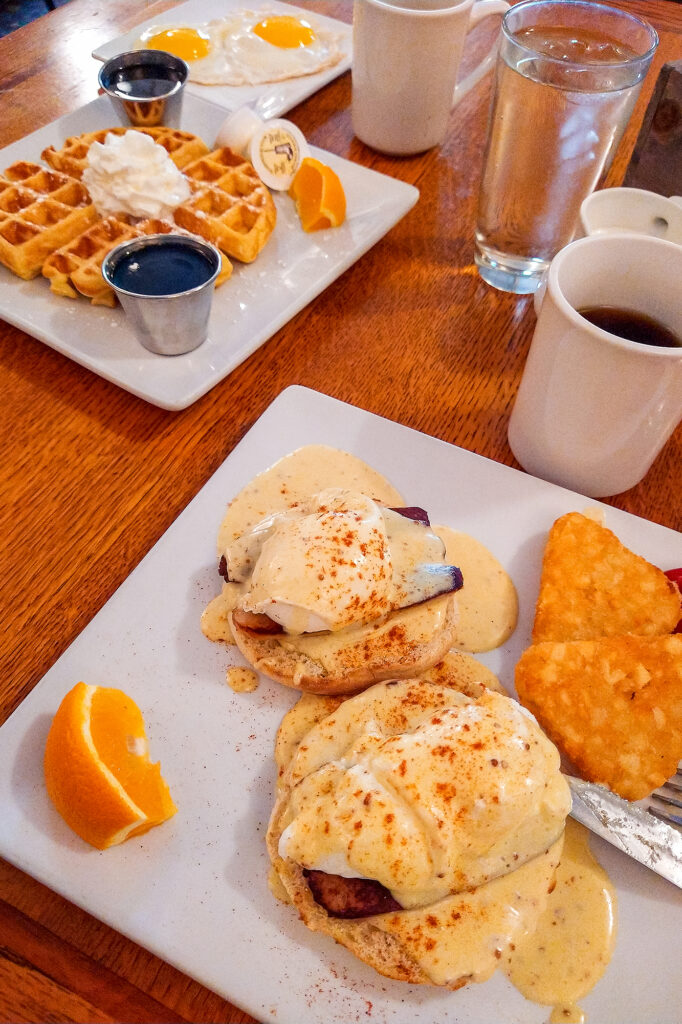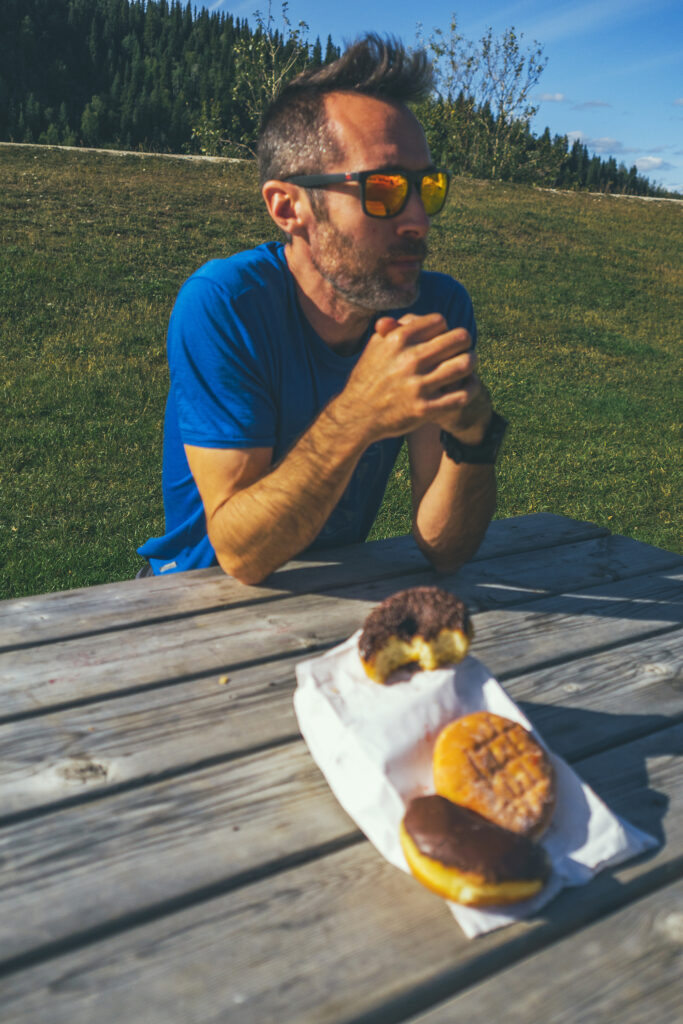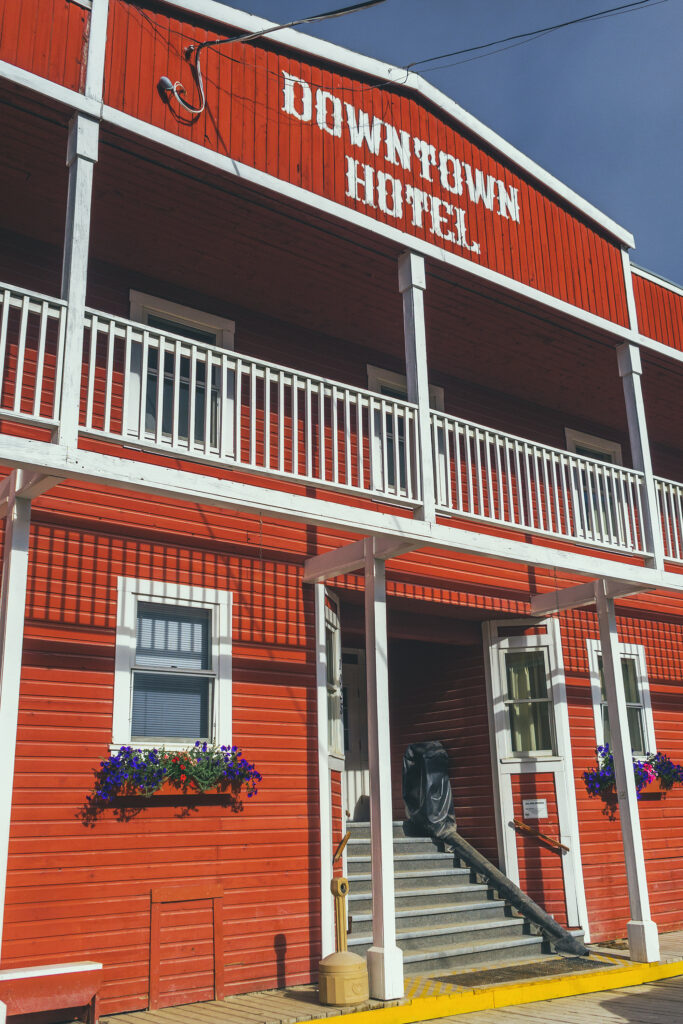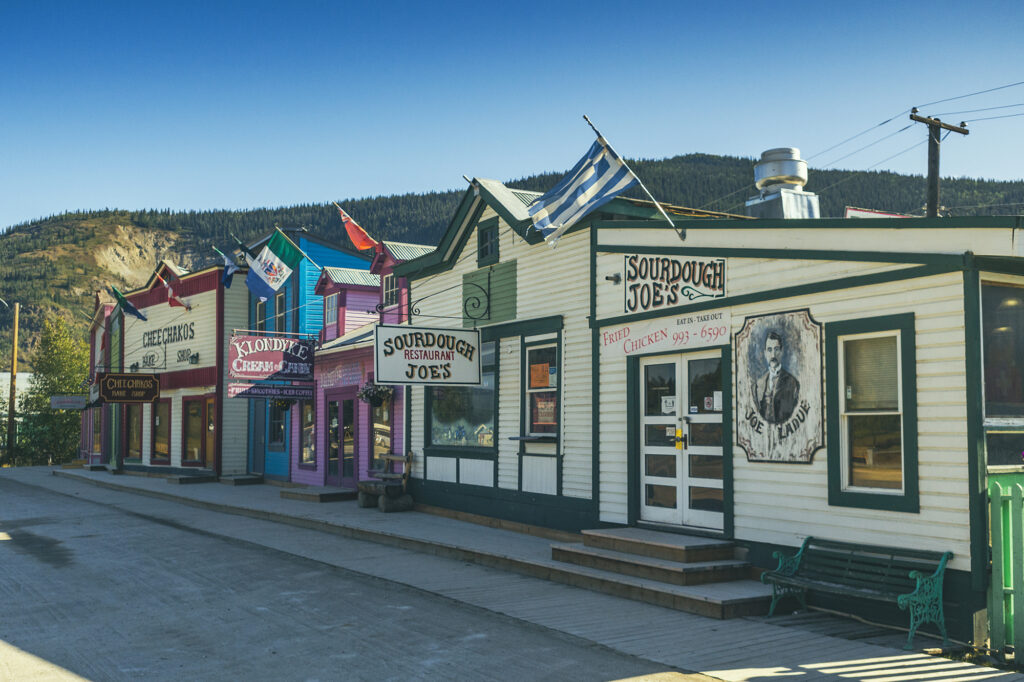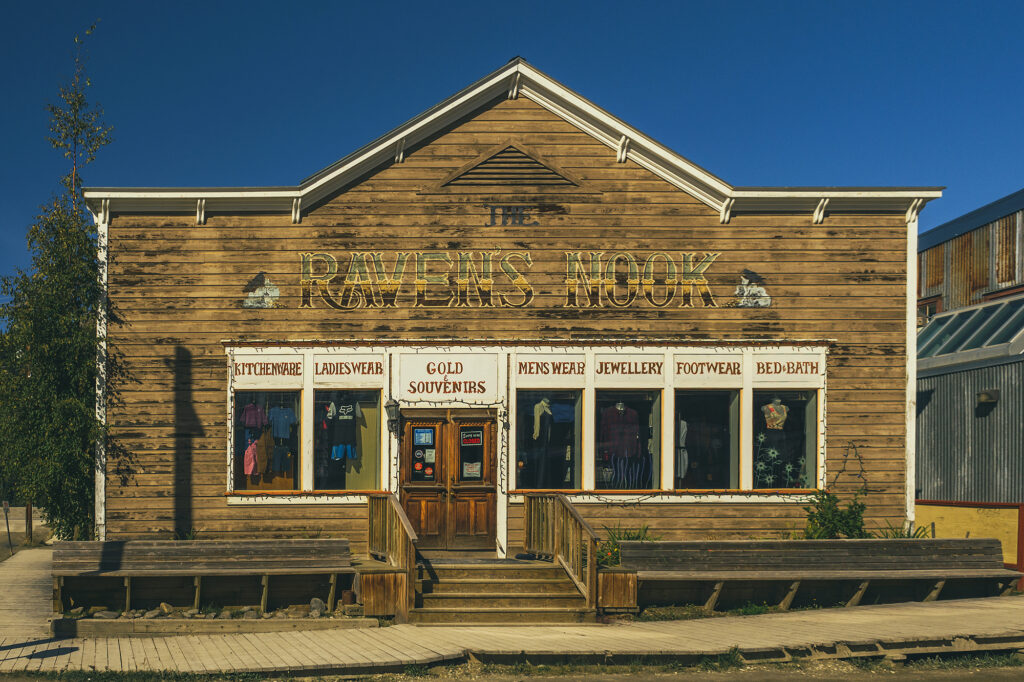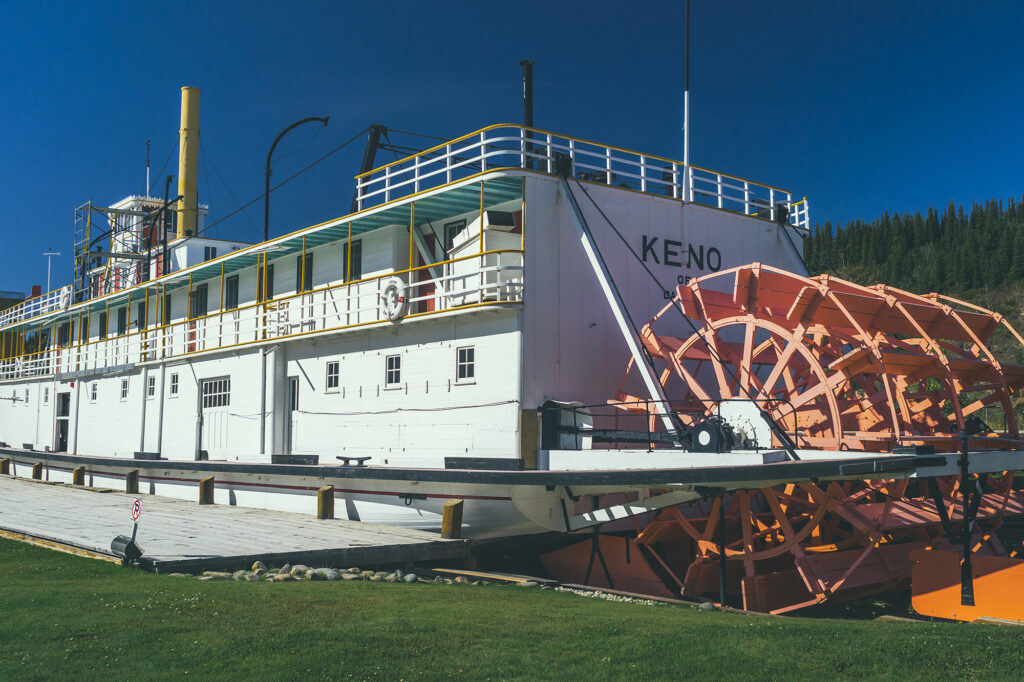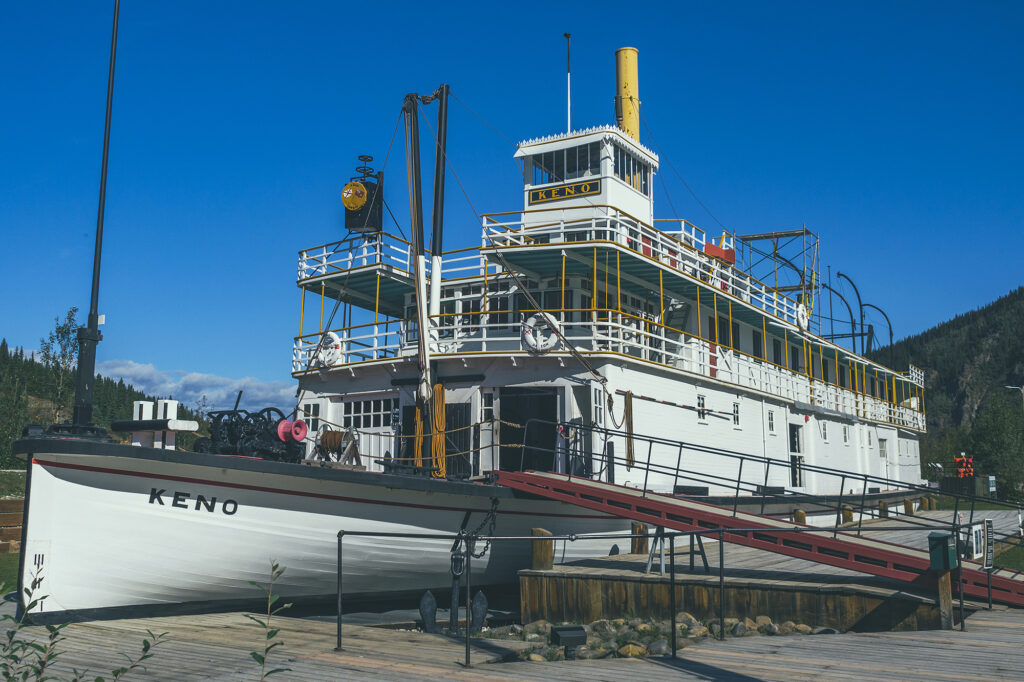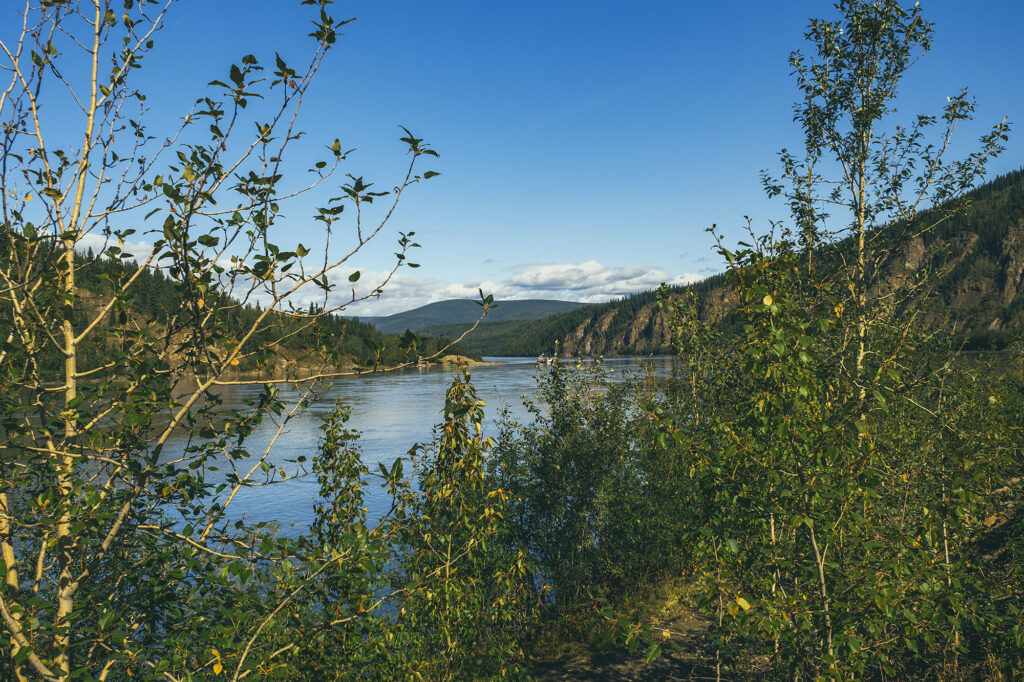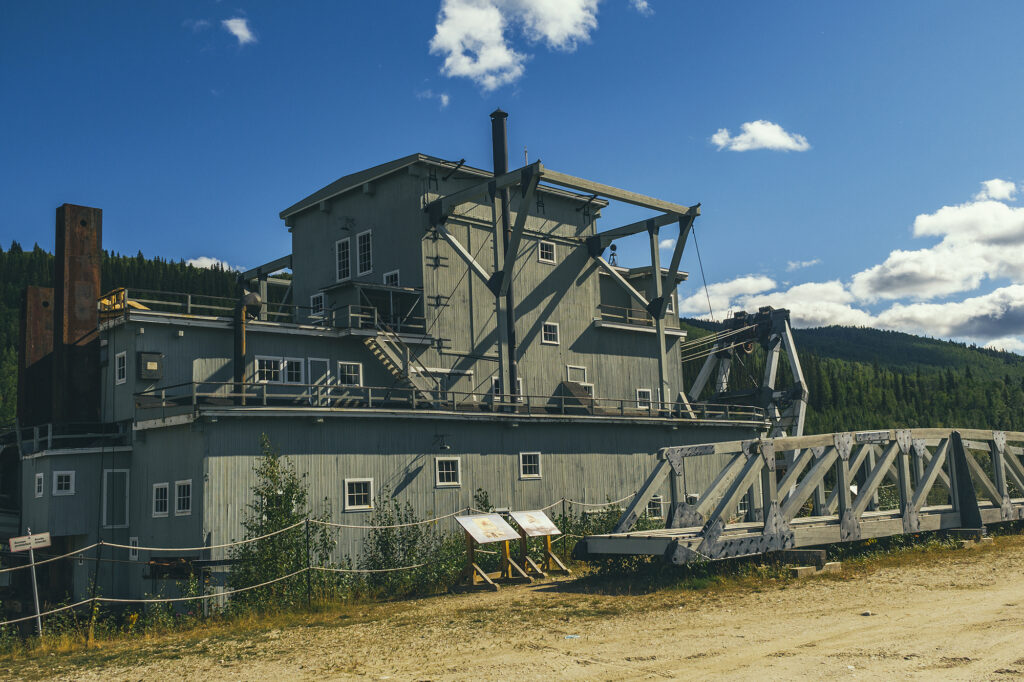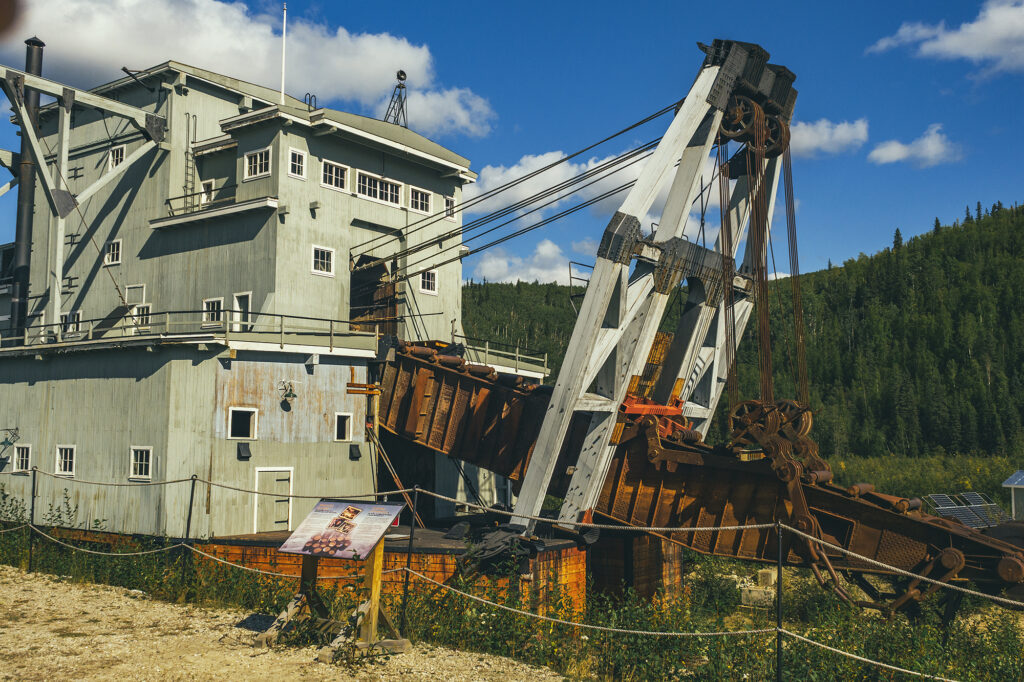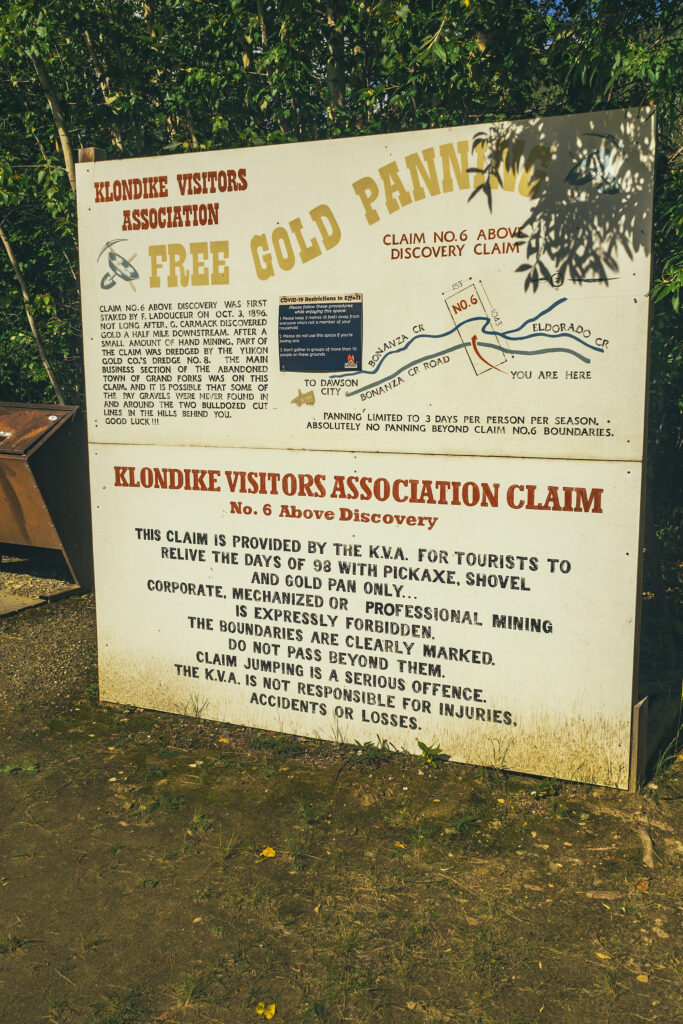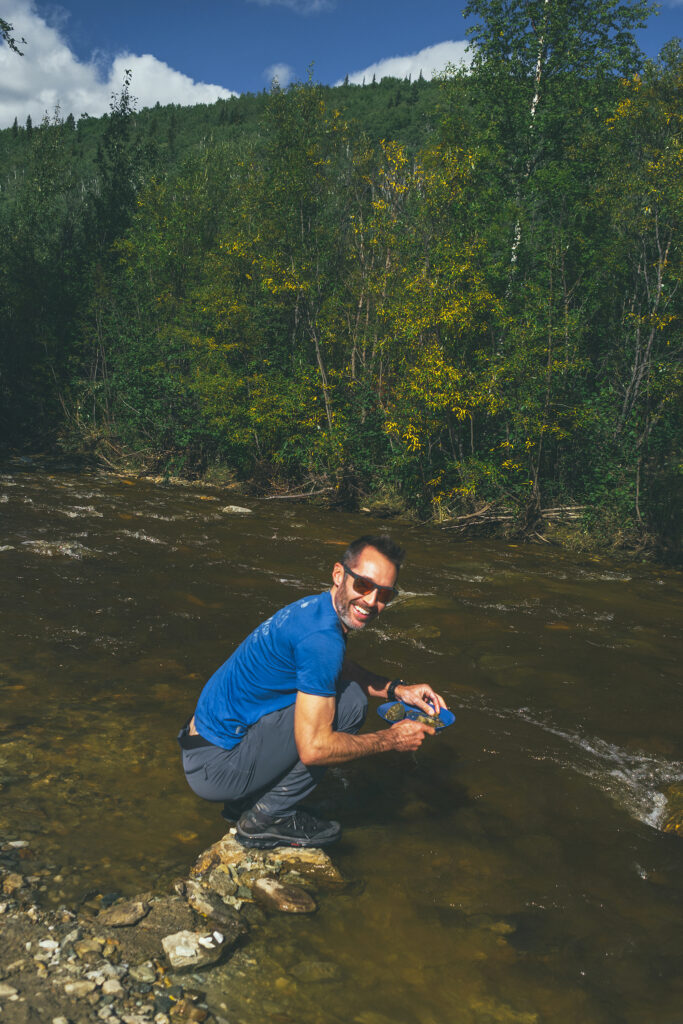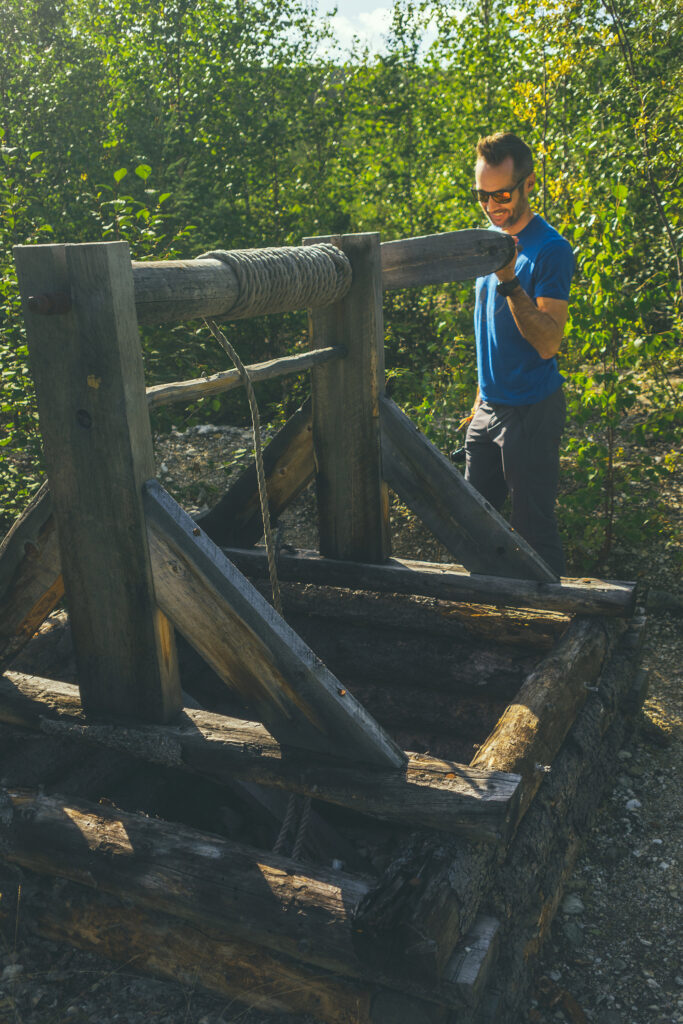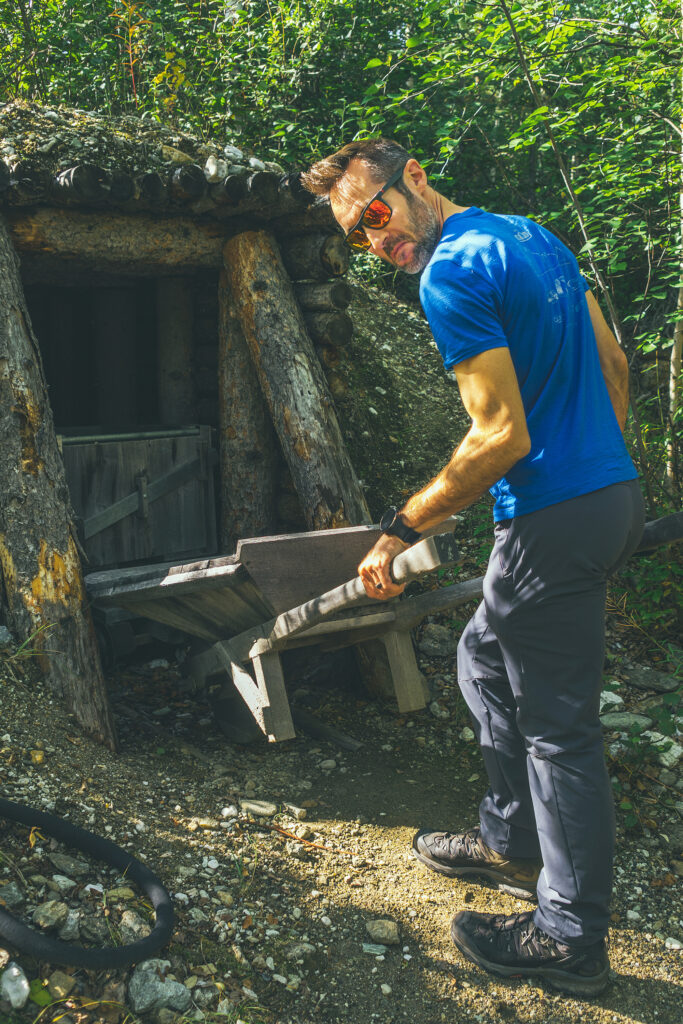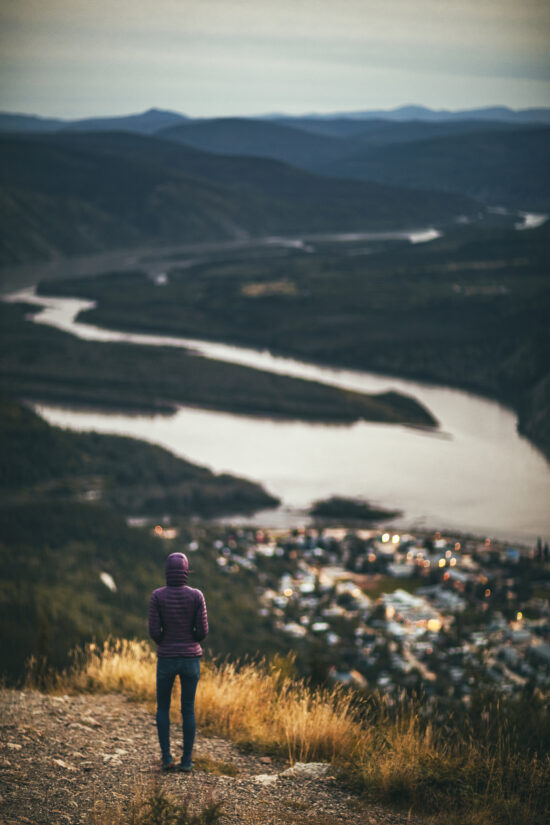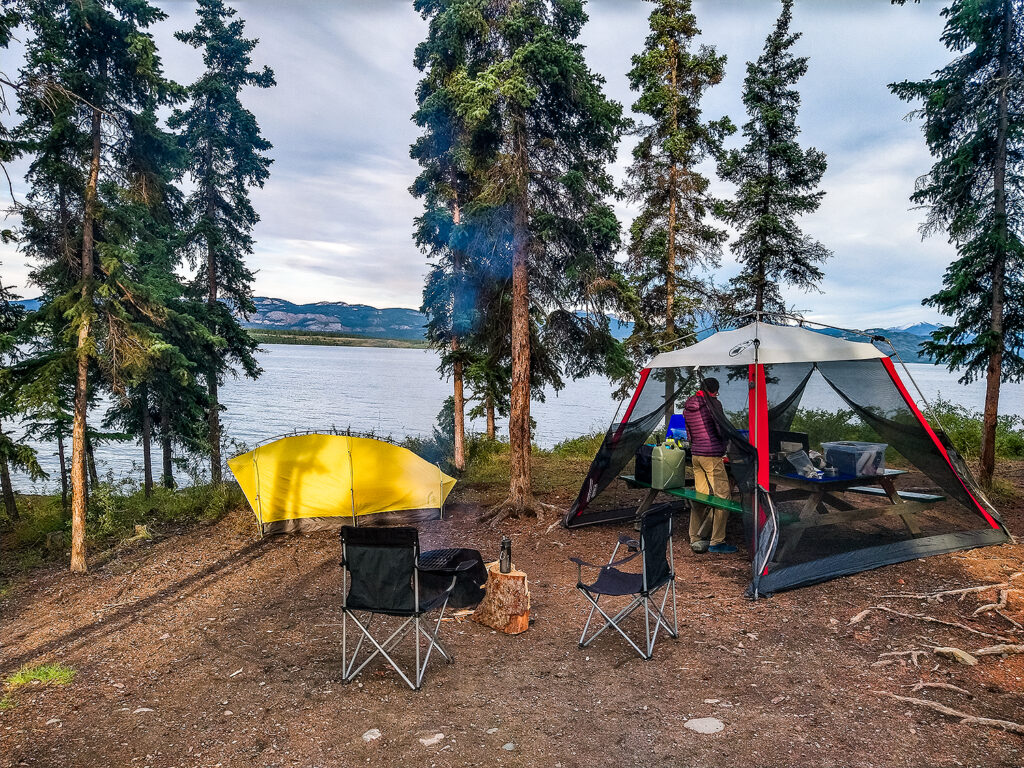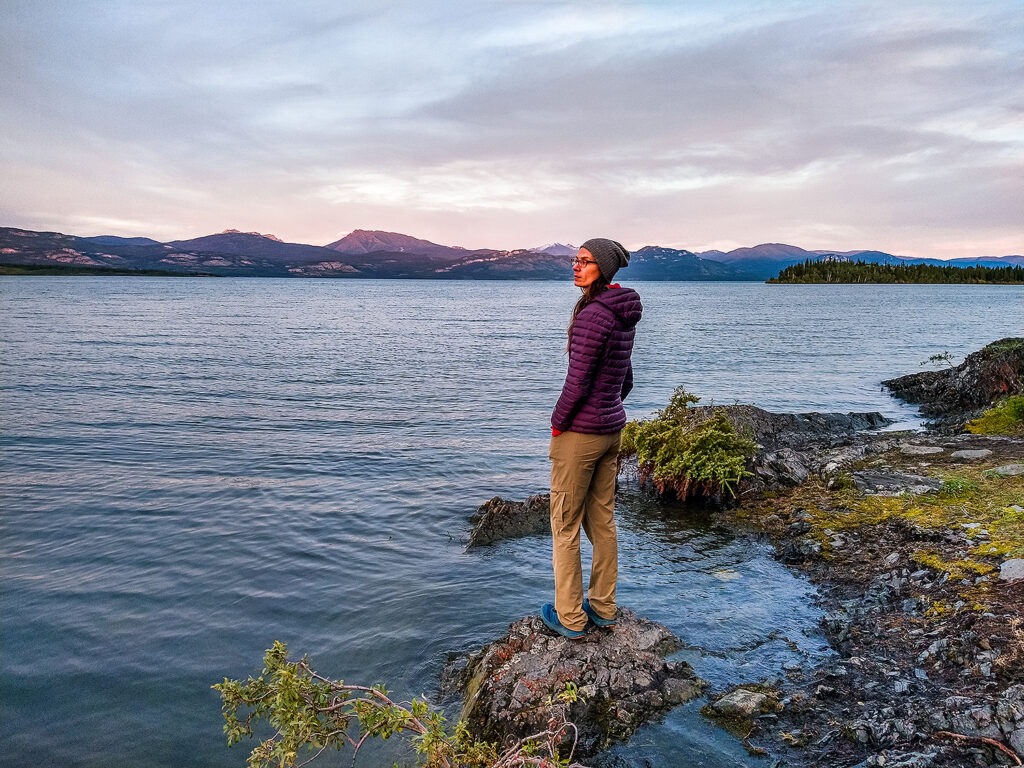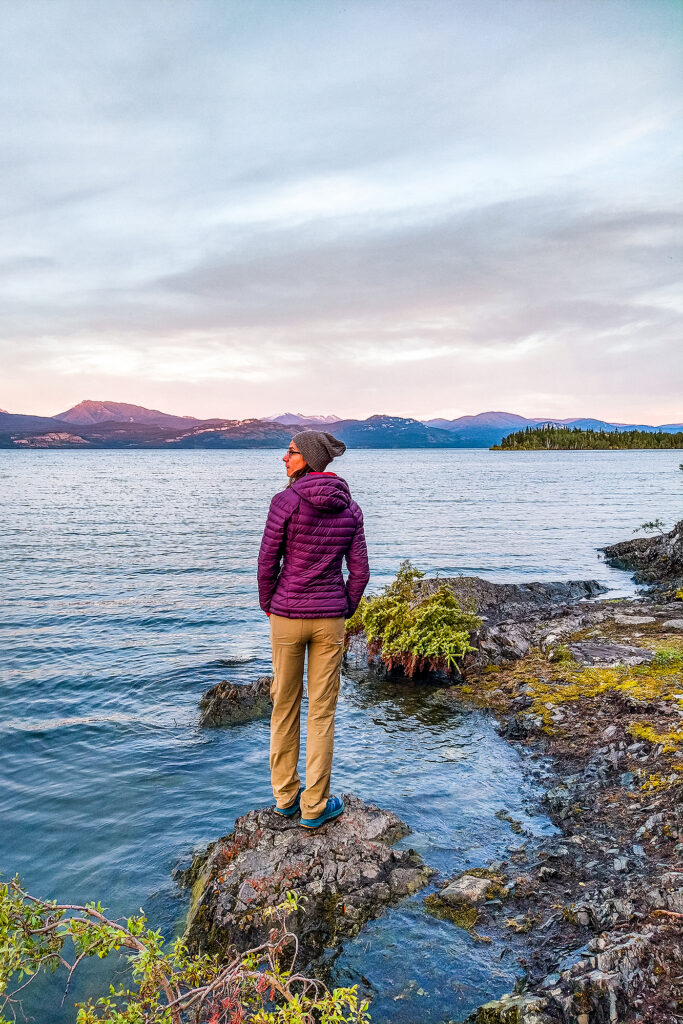August 22 – In and Around Dawson City
We packed up the tent and went for breakfast in town. We first tried the Riverwest Bistro, but it had more of a coffee shop vibe and was a bit crowded so instead we sat at the Jack London Grill, inside the Downtown hotel, for a proper eggs benny and waffles type of deal.
The plan for the morning was strolling through Dawson City, and go to the Dänojà Zho Cultural Centre – but it ended up being closed on Sunday unfortunately. We went back to the Trading Post, now our favorite store, with its mix of outdoor supplies and miscellaneous antique items. It’s one of those stores that makes you want to buy all the things for your outdoor needs, but we only got propane bottles and an extra tarp, so we could keep both out bug shelter and sleeping tents dry from the rain.
Dawson City is located on the land of the Tr’ondëk Hwëch’in first nation, descendant of the of the Hän-speaking people who lived along the Yukon River for millenia. The Tr’ondëk Hwëch’in people traveled extensively over roughly 10,000 square kilometers of land, therefore designated as their traditional territory. Salmon, Caribou and Moose were some of their main source of food and the the land procured a wealth of other supplies, used in trades with neighboring nations. Contact with European settlers presented opportunities for trading of new goods, but also challenges due to the impact and influence on the Han culture, and of course the loss of land.
The discovery of gold and stampede resulted in the displacement of the Han people, and significant impact on their food sources by driving away the game. A highly regarded and respected member of the clan during the Gold Rush, Chief Isaac witnessed the impact of the European culture on his people and entrusted their traditional songs and dances with a neighboring nation in Alaska, to keep them alive until a time the Han could receive them back.
In the 1970’s, Yukon First Nations started the process of reclaiming their lands through negotiations with the Canadian government. Trʼondëk Hwëchʼin’s individual Land Claim and Self Government Agreement was first negotiated in 1991 but the Final Agreement wasn’t signed and put into effect until 1998. Today the Trʼondëk Hwëchʼin are actively working towards restoring their cultural heritage and traditions, while being active participants in the preservation and protection of the land we had the privilege to explore during our time there.
As for the founding of Dawson City and what remains today, its history is tightly woven with that of the Klondike Gold Rush. While settlers were stampeding up the Yukon river to stake claims on land that would hopefully yield them wealth, one business-savvy man, Joseph Ladue, decided to claim an area of boggy marsh land, at the mouth of the river. He figured all these people would need a place to live and expand as a community and sure enough, the town grew to roughly 5000 people within 6 months of Ladue first naming Dawson City. Today the town population is roughly 1600 people, the 2nd most populated town in the Yukon, after Whitehorse, and subsists mainly thanks to tourism.
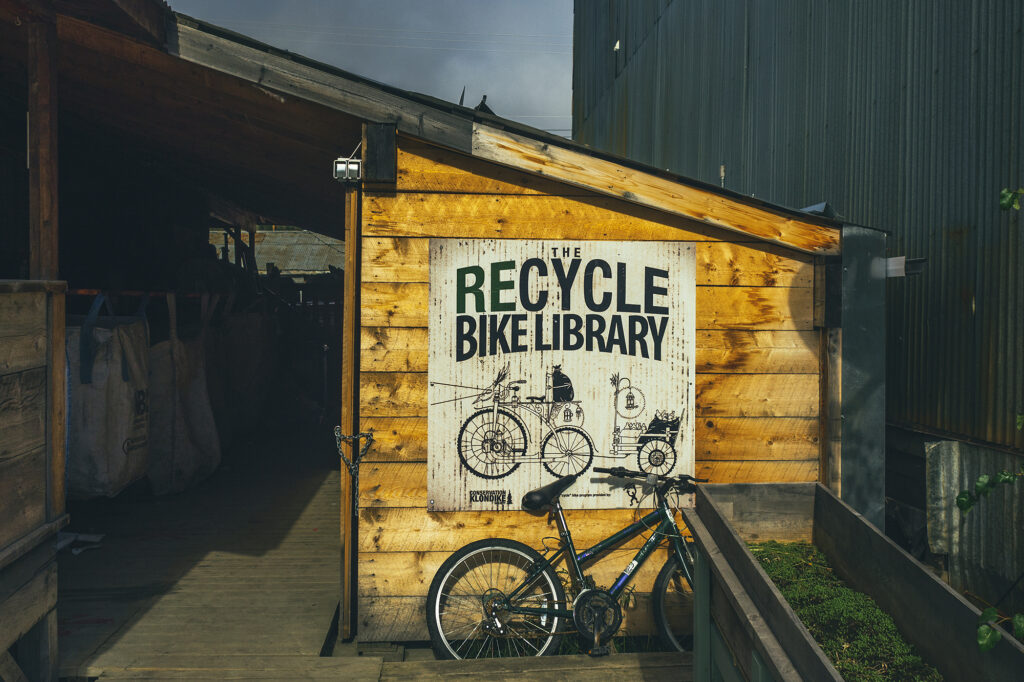
The day turned out to be quite sunny, which was a nice change, and we had lunch on one of the wooden platforms near the river. In the afternoon we headed down Bonanza Creek road, to visit a few different sites related to the Gold rush.
Dredge n°4 is a huge piece of machinery (the biggest of its kind) which was used to basically turn the river bed upside down to extract gold from it. At the time it was used (from the early 1910’s to the late 1950’s), it was the epitome of placer gold extraction engineering, and the most advanced it got from the original human labor of swishing dirt in a pan, at the start of the gold rush in the late 1890’s.
The design was, in itself, pretty straight forward: a series of huge cast-iron buckets on a chain, similar to a treadmill, would dig through the creek bed and pull the dirt out. As it traveled through the machine and a trommel screen mechanism, the heavier gold would fall down into a container while the rest of the rocks and dirt would get spit out the other end, creating a new mound of dirt where the creek used to be. This method was definitely more aggressive on the environment than manual gold panning, but certainly more efficient as Dredge 4 collected approximately nine tons of gold during its time of operation.
Our next stop was at Claim #6, a section of the Bonanza Creek owned by the Klondike Visitors Association and inviting visitors to do their own gold panning. It felt like a bit of a gimmicky tourist attraction, but since it was free we went along. Turns out there were a couple of groups there already, that seemed to take the task quite seriously, sitting in chairs with rubber-booted feet in the river and pans a-swishing.
If I’m being honest, it kind of reminded me of people walking on beaches with metal detectors, but gratuitous judgement aside, it definitely helped put into perspective the grit and determination of the people who originally came to the area, working for hours in harsh conditions, hoping to luck out on some flakes of gold
Lastly we went to the Discovery claim, a short interpretive trail along the creek in the location where gold was first found, which resulted in the Dawson City stampede and gold rush. The trail provided detailed information about the men who first claimed the area (George Carmack, Dawson Charlie, and Skookum Jim), as well as various tools that were used for mining.
After this deep-dive into the Gold Rush era, we headed back to the motel to check into our room for the night, then had snacks from the coffee shop, and finally went back to the room to rest for a bit and do a load of laundry.
For dinner we first tried Sourdough Joe, whose menu offered more fish and chowder options but when we got there at 8:30pm, it was completely empty. Looking for something a bit more alive, we tried going back to the Sourdough Saloon, where we had dinner the night before, but that was closed. So as last result we went back to the Greek place, the Drunken Goat, which, just like the night before Tombstone, was making “Pizza Only” (which makes me wonder if they actually ever do any actual Greek food?). At least the place was busier, including with the one guy who seemed to show up everywhere we had been each night – confirming I guess that there weren’t many other options for nightlife. The patron in question was actually a very jovial- albeit loud, regular local, acquainted with the staff and ultimately very friendly.
We ordered 2 pizzas and they came much quicker than the first time, except they got Brice’s order wrong and added Pepperoni to his vegetarian pizza. He’s not usually one to send food back, but he’s been voluntarily off meat since the start of the year and that wasn’t something he was willing to let slide, so they made a new pizza.
Finally we went and enjoyed a nice indoor sleep. After the disappointment of not finding a room for the night after we came back from our hiking trek, I had found one for the following night. It was a nice reset to be in a real bed with a real bathroom for a night.
August 23 – Drive back to Whitehorse
We picked up some breakfast pastries from the General Store, then we were on our way.
We pretty much just drove for about 6 hours. The nearest campsite to Whitehorse, without going into town, was Lake Laberge, so that’s where we stopped for the night. It turned out to be one of the best camping night we’d had on the trip.
We found a spot right on the water. The weather was quite nice, not cold, and we didn’t have any bugs. This one gets 5 stars on all criteria. We watched the sunset on the lake, and even though the sun actually set behind the trees, out of sight, we could see the light on the mountains across the lake changing colour as the sun went down, from gold to purple and pink. It was pretty special.
We had our how customary car-camping dinner of Couscous, beans, sardines. and enjoyed a lovely night with the sound of waves in the background.
The only thing that spoiled the night a bit was that my air mattress appeared to have a leak and kept deflating overtime. I had to blow it back up it at least 4 or 5 times throughout the night. Thankfully we’d brought a spare mattress for this very reason, so the following night I switched to the spare. It was lucky that it didn’t happen while we were hiking in Tombstone.

